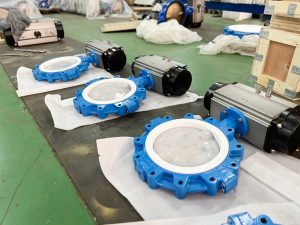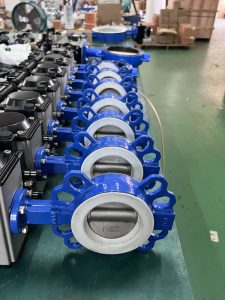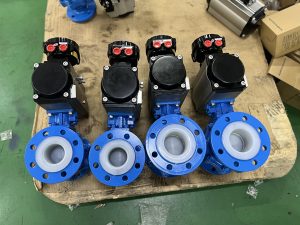Understanding the difference between PFA valve and PTFE valve material is crucial for selecting the right solution for industrial fluid control needs. Both materials, integral to high-performance valves like PTFE lined valve and PFA lined valve, offer exceptional chemical resistance and durability. PTFE, commonly known as Teflon, is valued for its high-temperature tolerance and robust chemical resistance. Making it a preferred choice in critical applications. PFA, on the other hand, shares many properties with PTFE but provides enhanced flexibility and crack resistance. Ideal for niche applications like semiconductor manufacturing. The blog explores key distinctions, including performance under harsh conditions, lifespan, cost-effectiveness, and typical applications of PTFE valves and PFA valves. By examining these factors, readers will gain insights into choosing between a teflon valve, PFA valve, or PTFE valve. Ensuring optimized performance and system longevity in their specific industry use case.

pfa valve and ptfe valve Introduction
Material selection is a critical factor in the design and performance of industrial valves, influencing their durability, efficiency, and suitability for specific applications. Among the most widely used materials in this field are PTFE and PFA, both renowned for their superior chemical resistance and adaptability across diverse industries. PTFE, commonly referred to as Teflon, has become synonymous with reliability in harsh environments. Making it the material of choice for components like PTFE valves and PTFE lined valve systems.
On the other hand, PFA offers a unique blend of properties. Including improved flexibility and resilience against cracking. Which positions it as the ideal option for specialized uses, as seen in PFA lined valve designs. The distinction between a PFA valve and PTFE valve lies in their performance under varying conditions. Such as temperature extremes, chemical exposure, and physical stress. Understanding these differences is vital for engineers and decision-makers who aim to ensure system integrity, minimize maintenance, and reduce operational costs. This article unpacks the key attributes of PTFE and PFA, how they impact valve functionality. And provides guidance on choosing between a PFA valve and PTFE valve for optimal results in industrial fluid control.

Understanding PFA and PTFE Materials
Polytetrafluoroethylene (PTFE) and Perfluoroalkoxy (PFA) are two high-performance fluoropolymers that play critical roles in the design and functionality of industrial valves. PTFE, widely recognized by its trade name Teflon, celebrate for its exceptional chemical resistance, high thermal tolerance, and low friction coefficien. Making it an indispensable material in the production of PTFE valves and PTFE lined valve systems used in industries such as chemical processing and pharmaceuticals.
On the other hand, PFA shares many properties with PTFE but offers enhanced flexibility. Improved crack resistance, and transparency. Which makes it a preferred choice for specialized applications like semiconductor manufacturing and corrosive gas handling. These qualities are particularly evident in PFA lined valve designs. Which are engineered for demanding environments where mechanical stress and chemical exposure are prevalent. While both materials excel in areas such as resistance to extreme temperatures and aggressive chemicals. Their differences make them suitable for distinct industrial scenarios. The versatility and reliability of these materials ensure that selecting between a PFA valve and PTFE valve depends largely on the specific operational requirements. Such as system rigidity, environmental demands, and longevity expectations. By understanding the unique characteristics of PTFE and PFA. Engineers and manufacturers can make informed decisions, ensuring optimal performance, safety, and cost-effectiveness in their fluid control systems.

Key Differences Between PFA Valve and PTFE Valve Materials
While both PFA and PTFE high-performance fluoropolymers know for their exceptional chemical resistance and durability. There are distinct differences between the two that greatly impact their application in industrial valves. PTFE, also commonly referred to as Teflon, renown for its outstanding resistance to extreme temperatures, low friction coefficient. And unmatched stability in chemically aggressive environments. Making it a popular choice for PTFE valves and PTFE lined valve systems used in industries such as chemical processing, oil and gas, and pharmaceuticals.
On the other hand, PFA offers similar chemical resistance but provides added benefits. Such as improved flexibility, superior crack resistance, and the ability to maintain its integrity under mechanical stress. These features make PFA lined valve systems especially well-suited for demanding applications such as semiconductor manufacturing and handling corrosive gases. The key difference lies in the material properties under stress and thermal conditions. While PTFE excels in high thermal resistance and static applications. PFA’s flexibility and structural integrity under dynamic conditions give it an edge in environments requiring resilience against mechanical wear or thermal cycling. Selecting the right solution between a PFA valve and PTFE valve depends on the specific requirements of your operation. Including factors like operating temperature, chemical exposure. And mechanical loads. Understanding these differences allows engineers to optimize system longevity and performance while reducing maintenance costs in a wide range of industrial fluid control applications.
Applications of PFA and PTFE Valves
PFA and PTFE valves are integral components in a variety of industrial applications due to their exceptional chemical resistance and durability. PTFE, widely recognized as Teflon, commonly use in PTFE valves and PTFE lined valve systems for industries like chemical processing, pharmaceuticals, and oil and gas. Its ability to withstand extreme temperatures and resist harsh chemicals makes it indispensable for processes involving highly corrosive or reactive substances. On the other hand, PFA valves and PFA lined valve systems are specifically designed for even more demanding environments. With enhanced flexibility, superior crack resistance. And the ability to maintain structural integrity under dynamic conditions. PFA valves excel in applications such as semiconductor manufacturing, where purity and resilience are paramount.

Both PFA and PTFE are used in environments requiring minimal friction and no contamination. But their distinctions in mechanical strength and thermal performance often dictate their suitability for specific tasks. For example, while a PTFE valve might be ideal for static applications in high-temperature settings, a PFA valve offers advantages in dynamic systems where mechanical stress and thermal cycling occur. Whether discussing PFA valve and PTFE valve requirements for corrosive fluids, gas handling. Or precision-focused industries, the unique properties of these materials allow for safe, efficient, and long-lasting fluid control in critical applications.
Benefits of PFA and PTFE Valves
PFA and PTFE valves offer a wide range of benefits that make them indispensable in industrial fluid control systems. Both materials are renowned for their outstanding chemical resistance. Allowing them to perform reliably even when exposed to highly aggressive or corrosive substances. PTFE, commonly recognized as Teflon, showcases exceptional resistance to extreme temperatures and low friction. Making PTFE valves and PTFE lined valve systems ideal for processes requiring stability and safety in harsh chemical environments.
Similarly, PFA valves and PFA lined valve systems build on these properties while offering additional advantages such as enhanced flexibility, superior crack resistance. And the ability to handle mechanical stress and thermal cycling. These attributes ensure that PFA valve and PTFE valve solutions deliver long-lasting durability and reduced risk of failure under demanding conditions. Their versatility extends across industries including chemical processing, oil and gas, pharmaceuticals, and semiconductor manufacturing. By minimizing wear, reducing maintenance requirements, and sustaining operational reliability in critical systems, PFA and PTFE valves enhance overall efficiency. Additionally, the ability of these valves to prevent contamination makes them an excellent choice for applications where purity is paramount. Whether selecting a PTFE valve for a high-temperature application or a PFA valve for dynamic mechanical loads, the benefits provided by these materials contribute to cost-effectiveness, system longevity, and optimal performance in industrial operations.
Choosing Between a PFA Valve and PTFE Valve
Choosing between a PFA valve and PTFE valve requires a thorough evaluation of your specific operational needs. As both options excel in distinct industrial environments. PTFE, widely recognized as Teflon, is a material of choice for PTFE valves and PTFE lined valve systems due to its unrivaled chemical resistance and ability to withstand extreme temperatures. This makes PTFE an excellent option for static applications and industries that require resilience in chemically aggressive or high-temperature conditions, such as chemical processing, oil and gas, and pharmaceuticals.
On the other hand, a PFA valve or PFA lined valve offers similar chemical compatibility but engineer with enhanced flexibility. Superior crack resistance, and the ability to endure repeated thermal cycling and mechanical stress. These features make PFA valves particularly suitable for dynamic environments, such as those in semiconductor manufacturing and precision fluid systems, where material integrity under stress is critical. When making a decision, factors like chemical exposure, operating temperature, mechanical load, and cost must be carefully weighed. For instance, a PTFE valve might be ideal for processes requiring high thermal resistance without frequent mechanical impact, while a PFA valve stands out in situations where durability under cyclical conditions or purity standards are paramount. By aligning the choice of material with specific industrial requirements, operators can ensure optimal performance, longevity, and cost-efficiency in fluid control systems..

Summary and Recommendations
PFA and PTFE valves, widely recognized for their exceptional chemical resistance and durability. Are critical components in industrial fluid control systems across various sectors. PTFE, commonly referred to as Teflon, exhibits unparalleled resistance to aggressive chemicals and extreme temperatures.Making PTFE valves and PTFE lined valve solutions ideal for static applications in harsh environments such as chemical processing, oil and gas, and pharmaceuticals. PFA valves and PFA lined valve systems, while offering similar chemical resilience. Provide additional benefits like enhanced flexibility, superior crack resistance, and the ability to withstand mechanical stress and thermal cycling.
These qualities make PFA valves a preferred choice for dynamic applications, such as those found in semiconductor manufacturing or systems requiring high material purity. When selecting between a PFA valve and PTFE valve, factors like operating temperature, chemical compatibility, exposure to mechanical stresses, and long-term cost considerations should guide the decision. A PTFE valve may be the best option for high-temperature static systems. While a PFA valve highly recommend for environments involving repetitive mechanical loads or stringent purity standards. Understanding these properties and differences ensures that operators can achieve optimal performance, system longevity, and cost-effectiveness, while addressing the specific demands of their industrial processes.
FAQ
Q1. What is the warranty period for your pfa valve?
Pfa valve come with a standard warranty period of 12 months (1 years) from the date of delivery. This warranty covers manufacturing defects and materials under normal operating conditions as specified in the product manual.
Q2. How are? Pfa valve prices determined?
Prices for Pfa valve is influenced by several factors. Including the valve’s size, material composition (e.g., stainless steel, brass, or PVC), pressure ratings, end connection types. And any additional customisation or certifications required. Specialised features such as fire-safe designs or anti-static devices can also impact the cost.
Q3. What is the standard delivery time for a Pfa valve?
Our standard delivery time for Pfa valve is 4–6 weeks, depending on the order size and customisation requirements. For urgent requests, we offer expedited delivery options upon request.
Our logistics partners ensure fast and reliable delivery to meet engineering project timelines, regardless of location.
Q4. Common Applications of? Pfa?valve
Pfa valve a versatile valve type design with three/two ports for fluid flow. These ports can be configured to allow various functions. Such as mixing, diverting, or completely shutting off flow.

pfa valve and ptfe valve Conclusion
PFA and PTFE materials each excel in distinct applications, making the choice between a PFA valve and PTFE valve highly dependent on operational requirements. PTFE, commonly recognized as Teflon, offers outstanding chemical resistance and remarkable thermal stability. Making PTFE valves and PTFE lined valve systems ideal for static environments exposed to extreme temperatures and aggressive chemicals. This makes them a reliable option for industries such as chemical processing, oil and gas, and pharmaceuticals.
On the other hand, PFA valves and PFA lined valve systems combine similar chemical resistance with superior mechanical flexibility, crack resistance, and the ability to endure thermal cycling. These features make PFA particularly well-suited for dynamic applications like semiconductor manufacturing or systems requiring high purity standards. Ultimately, while PTFE provides resilience in harsh, static conditions, PFA better handles dynamic stresses and repeated thermal variations. Carefully considering factors like chemical compatibility, temperature, mechanical load, and purity needs will help operators choose the most effective solution. Whether it’s a Teflon-based PTFE valve or a PFA valve for more demanding mechanical conditions, these materials ensure efficiency, durability, and cost-effectiveness in diverse industrial applications.

